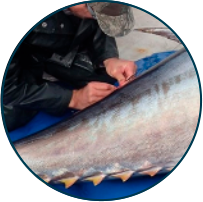Aims to understand the biology of tunas in the Tropical Eastern Pacific Ocean, using various approaches.
Buscapez

YELLOWFIN TUNA
The species gets its name for the bright yellow color of its anal fin, dorsal fin, and finlets (the small fins between the dorsal or anal fin and the tail fin). In older individuals, the anal and dorsal fins can extend all the way back to the tail fin.
It is one of a few “warm-blooded” fish species and has a torpedo shaped body. These two characteristics turn it into a top predator highly adapted to swim at high speeds. As a top predator, yellowfin tuna has a critical role in regulating the food chain, and limiting the population. of fish (e.g. flying fish or other smaller tuna species) and squid.

A culturally important fishery
Tuna fisheries are an important source of wealth and employment in the Eastern Pacific Ocean, more than 66% of tuna worldwide comes from this area.
Ecuador is one of the most important producers of tuna, which translates to 1.2 billion dollars of income and close to 50000 job positions in the country.

Status of yellowfin tuna
The IUCN lists the yellowfin tuna as a species of least concern, but specifies that its populations are declining. According to the last scientific publications, the tuna population structure is unclear and despite some spawning areas being identified in various regions, countries like Ecuador do not have information about spawning grounds and seasons in the area, migrations, and sexual maturity size.
You can find more information about yellowfin tuna in:
To read a brief detail about each one of the research lines, read the tab about the Project
The Problem
Much like many other species of fish, tuna populations are undergoing active overexploitation. Successful conservation and management plans depend on accurate information about the species but, despite its ecological and commercial importance, there are still many large gaps to fill in what is known about the yellowfin tuna in the Tropical Eastern Pacific Ocean.

What we do
Using various approaches, we research:
OUR TEAM
What we pursue and have achieved
Tunas have been historically disregarded as key components of healthy environments and critical pillars of the economy and culture of coastal communities.
Our aim is to understand the biology and ecology of this species, producing as much useful, applicable knowledge as possible, to facilitate the development of efficient conservation and management policies that ensure its survival for the sake of the ecosystems and the peoples that depend on them. Our work has rendered its first scientific findings, resulting not only in papers in revision, but also in important collaborations with scientists from different countries and institutions on the Pacific basin. More importantly, it has helped us to cement a close relation with the local artisanal fishing communities, who understand that conserving this precious species means protecting they own livelihoods and the future of their communities.

Our next step
We are currently expanding both the scope and the area of coverage of our study. We will start a telemetry study to determine short- and long-range migration patterns of this magnificent fish. For this, we will tag 30 individuals in each country, with radio emitters that can be detected by the array of receivers around the islands and along the Cocos-Galápagos swim way.
We know education is a crucial component of successful conservation plans, so we are developing materials and contents for educational workshops for the children of the fishing communities as well as with the fishers themselves. To learn more about the project and our work with the communities, check about the Project.










